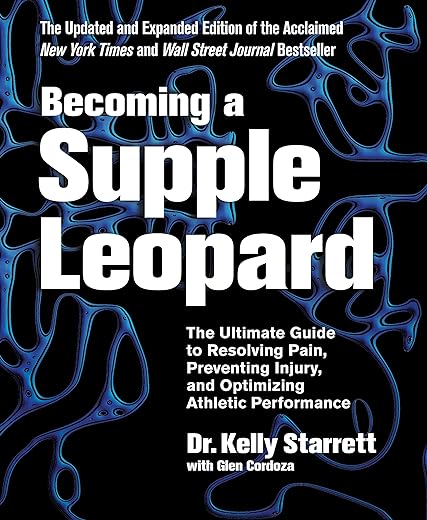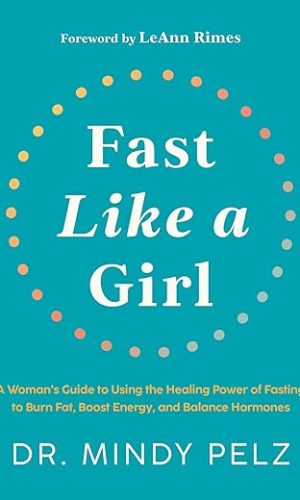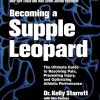Becoming a Supple Leopard: The Ultimate Guide to Resolving Pain, Preventing Injury, and Optimizing Athletic Performance
£44.10£54.10 (-18%)
Updated and expanded with more than 80 pages of new content!
Improve your athletic performance, extend your athletic career, treat stiffness and achy joints, and prevent and rehabilitate injuries – all without having to seek out a coach, doctor, chiropractor, physical therapist or masseur. In Becoming a Supple Leopard, Dr. Kelly Starrett – founder of MobilityWOD.com – shares his revolutionary approach to mobility and maintenance of the human body and teaches you how to hack your own movement, allowing you to live a healthier, more fulfilling life. This new edition of the New York Times and Wall Street Journal bestseller has been thoroughly revised to make it even easier to put to use.
Want to truly understand the principles that guide human movement? Becoming a Supple Leopard lays out a blueprint for moving safely and effectively through life and sport. Want to learn how to apply those principles to specific movements, whether you are doing squats in the gym or picking up a bag of groceries? Hundreds of step-by-step photos show you not only how to perform a host of exercise movements, such the squat, deadlift, pushup, kettlebell swing, clean, snatch, and muscle-up, but also how to correct the common faults associated with those movements. Frustrated because you can’t perform a certain movement correctly due to range of motion restrictions? Breaking the body down into 14 distinct areas, Starrett demonstrates hundreds of mobilization techniques that will help you resolve restrictions and reclaim your mobility. Unsure how to put it all together into a program that addresses your individual needs? This updated edition lays out dozens of prescriptions that allow you to hone in on a specific limitation, a nagging injury, or an exercise fault that you just can’t seem to get right. It even offers a 14-day full-body mobility overhaul.
Performance is what drives us as human beings, but dysfunctional movement patterns can bring the human body to an abrupt halt. Often, the factors that impede performance are invisible even to seasoned athletes and coaches. Becoming a Supple Leopard makes the invisible visible. Whether you are a professional athlete, a weekend warrior, or simply someone wanting to live healthy and free from physical restrictions, this one-of-a-kind training manual will teach you how to harness your athletic potential and maintain your body.
Learn how to perform basic maintenance on your body, unlock your athletic potential, live pain-free… and become a Supple Leopard. This step-by-step guide to movement and mobility will show you how to:
- Move safely and efficiently in all situations
- Organize your spine and joints in optimal, stable positions
- Restore normal function to your joints and tissues
- Accelerate recovery after training sessions and competition
- Properly perform strength and conditioning movements like the squat, bench press, pushup, deadlift, clean, and snatch
- Build efficient, transferable movement patterns and skill progressions from simple to more advanced exercises
- Identify, diagnose, and correct inefficient movement patterns
- Treat and resolve common symptoms like low back pain, carpal tunnel, shoulder pain, and tennis elbow
- Prevent and rehabilitate common athletic injuries
- Use mobilization techniques to address short and stiff muscles, soft tissue and joint capsule restriction, motor control problems, and joint range of motion limitations
- Create personalized mobility prescriptions to improve movement efficiency
Read more
Additional information
| Publisher | Revised edition (14 May 2015), Victory Belt Publishing |
|---|---|
| Language | English |
| Hardcover | 504 pages |
| ISBN-10 | 1628600837 |
| ISBN-13 | 978-1628600834 |
| Dimensions | 22.35 x 3.56 x 28.45 cm |










by buyer
Excellent book. If you’re interested in improving your mobilty, to get rid of pain or prevent getting injured, this is the book to read. So much to learn from this book. Pictures are thorough and easy to follow. Overall the book is easy to read if you’ve done, some terms might be new if you’re new to myofascia release, which basically means unknotting. But you can always Google things for info.
The ideas from the first 3 chapters are interesting, i.e starting with improving your core. Myofascia release on the core wasn’t something I didn’t know how to do and how important it was, but makes a big difference.
PrecisionMovement by Eric Wong has excellent courses and is easier to follow them reading the book. But I think having both available are all you need to build or maintain good mobility.
by Mae S
It seems odd to give a 5 star rating to a book that I immediately returned – but it didn’t feel fair to give it anything less. The volume is beautifully bound, abundantly illustrated and packed to the brim with hundreds of exercises, each accompanied by a photograph. It is so incredibly detailed that it feels more like a textbook to accompany a degree course in sports science, than a book for the layman looking to improve their physical condition. It was tempting to keep it because it is so lavish and comprehensive in scope. Thankfully, a rarely heard voice of reason whispered to me that the content of this book is so overwhelming that it would almost certainly never make it off the shelf.
by Clayton W.
After a short time absorbing and using some of the practices in this book my body is functioning way better.
by Horvath
This is THE go to book for mobility and stretching. Almost anyone involved in Crossfit or Martial Arts will recommend this to you when you ask about stretching. The book is huge and absolutely full of colourful photographs and explanations about the methods the author uses to bring gains in mobility. Whether you are looking to improve your range of motion for snatch technique, a high kick or simply reduce muscle stiffness from sitting at a desk all day, it is likely this book will give you all the knowledge you need.
One weakness I would point out is that you kind of have to read the whole book to really be able to put a programme together for yourself. One thing I think would have really benefitted this book is a few more ‘routines’. There are a couple in the back of the book that require you to flick back through the book to pages of exercise descriptions, but I think maybe a flow chart would have been better so that those who wanted to get started right away could do so without having to read the whole thing. I’m knit-picking a bit, but I think that would have made the book 5*.
by Mr. D. R. Radley
TLDR version – the book is only really useful if you’re an avid barbell athlete and you’re aware of issues regarding mobility and performance or your’e a coach. If you’re looking for fixes for everyday posture issues look elsewhere, like Youtube.
Bought this book around 2015, read the book at the time and now recently gone through it using some of the practices in the book.
How much you will get out of this book really depends on who you are and why you’re buying or more accurately what knowledge you’re seeking.
It’s also hard to review as a lot of the mobility techniques especially the smashing/foam rolling techniques are questionable in they’re use and effectiveness (will explain more later on)
I originally bought this book because I work out with barbells, I’m aware of issues with my mobility and have issues with day to day posture. At the time I never seemed to find help online at the time that worked so hence I bought this book.
Positives
– every day bracing technique, the start of the book describes how to brace and hold your body in everyday life from standing, sitting, walking. Useful info and definitely helps.
-Barbell/exercise/positional techniques and self analysis – the main bulk of this book is spent talking about different positional archetypes that are used in exercise e/g squat, over head, pressing, lunge etc how they should be performed, what can go wrong and how to identify them and then there’s a massive section on all the different mobility techniques to correct the issues relating to these movements/positions.
Some techniques work – one of the issues I have is over head extension, I can’t get my arm straight over head with out over extending my lumbar spine. I used a prescribed set of exercises to help fix this and I saw instant improvement. It wasn’t an instant fix, which in unrealistic, but there’s definite improvement which should only improve over time.
Negatives
The book is very, very, very much geared towards exercise movements. It does take a lot of time discussing bracing for everyday life and it is useful, very useful in fact, but it’s not going to fix any kind of serious every day issues and that’s the only day to day postural info it gives everything else is geared towards exercise movements.
For example if you have a anterior pelvic tilt (ATP) when you squat this book will help, how ever if you have a serious ATP in everyday life this book isn’t going to tell you what you need to do, it’s possible you could figure out what you need to do from all the techniques provided but as I’ve said various every day postural issues aren’t really addressed. The same goes with rounded upper back, rounded lower back, forward neck etc. The end of the book has some quick exercise lists based on pain issues for example lower back pain, hip pain etc but they are just that exercise lists and don’t discuss those issues.
Your fix might be in this book but you might not realise it – one of the things I realised whilst reading this book and self analysing myself is that regardless of how much info is in here it would be very easy to have a glaring issue that you won’t notice because you don’t have the experience. A coach/therapist might be able to watch you squat and find faults you don’t realise you have. Another scenario is that you might notice a fault and you try techniques number 1-6 to fix the issue and none work. A coach/therapist might be able to tell you that technique number 9 is the on that will work.
The fixing techniques themselves – the techniques are all either stretching, dynamic stretching or myofascial release (foam rolling, smashing). Without going into too much detail on the validity and appropriateness of these techniques I’ll discuss what I experienced.
As stated in the positives the over head extension fixes seem to be working for me but the fixes for ATP in the squat haven’t worked. I didn’t see that instant improvement even a minor one after doing 15 mins of work to improved it. Now is this because my everyday postural ATP is so bad….possibly.
Foam rolling and smashing techniques – when this book originally came out 2013 foam rolling and myofascial release techniques were about to become the new gym fad. By 2015 you couldn’t walk into a gym without seeing people one the floor rolling they’re IT bands (it was always the IT bands) and slowly, like kettlebells, the fad went away. Is this because the techniques didn’t work or because people got sick of rolling around in pain for 15 minutes before and after (sometimes during too) every work out, because I sure did.
Foam rolling and smashing techniques are painful and the book tells you this and that they’re supposed to be painful.
It also tells you that the minimum amount of time you need to spend ‘smashing’ is 2 minutes….that’s the minimum….for each limb/side….everyday….multiple times a day……and most fixes include one or two smashing techniques. So for example if you need to work on your quads and lats you’re going to be doing at minimum 4 different techniques for each side so that’s a minimum of 16 minutes. Add onto that any time performing stretching or mobility techniques and then your warm ups if you’re doing these before a workout and you’re looking at adding 30 mins at least onto your session.
My personal issues with the smashing techniques is the idea that we should be seeking out pain, if I move over a certain spot and it’s painful is that because there’s a problem there and it needs smashing or is it because my body weight is being pushed onto a small hard ball? Another issue I had is that the pain in some body parts such as glutes and calfs is still there the next day, almost like I suffered to some big trauma to the area or I did a big workout to failure the previous day. Does this mean it’s working or not working? Will this interfere with my work out performance?
by Tommy Smith
I would recommend this book only to the more dedicated athlete. The exercises shown and explained would not be available to the part-timer or the beginner. It has some great tips on stance, posture and techniques for safe lifting. The pictures are not easy to follow and the vocabulary is a little eye-brow and self-indulgent. That said, if you’re the type who likes to exercises the body and mind, then the Supple Leopard could be a great read and addition to the book self.